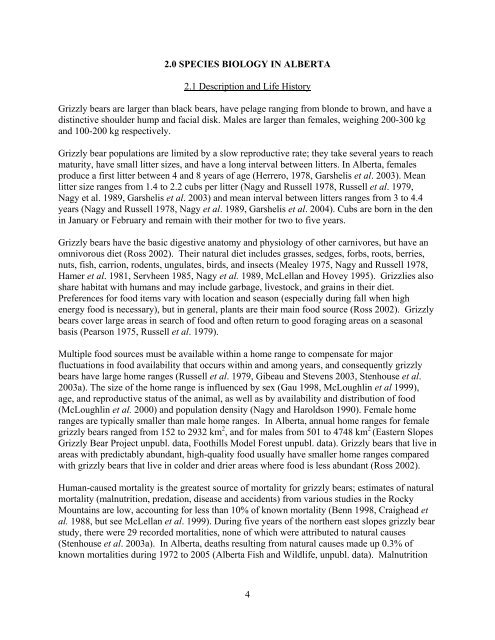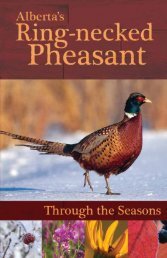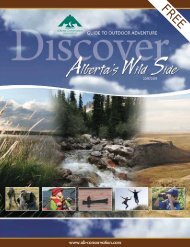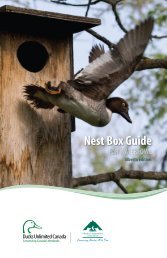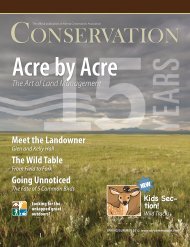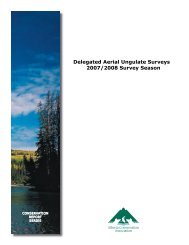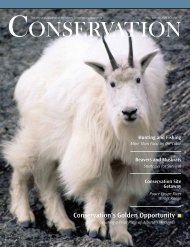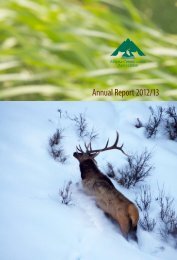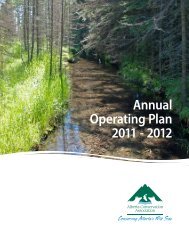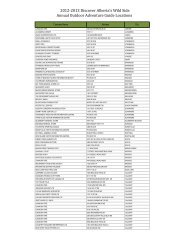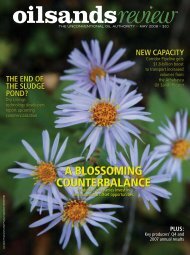Alberta Grizzly Bear Recovery Plan 2008-2013 - Alberta Sustainable ...
Alberta Grizzly Bear Recovery Plan 2008-2013 - Alberta Sustainable ...
Alberta Grizzly Bear Recovery Plan 2008-2013 - Alberta Sustainable ...
You also want an ePaper? Increase the reach of your titles
YUMPU automatically turns print PDFs into web optimized ePapers that Google loves.
2.0 SPECIES BIOLOGY IN ALBERTA<br />
2.1 Description and Life History<br />
<strong>Grizzly</strong> bears are larger than black bears, have pelage ranging from blonde to brown, and have a<br />
distinctive shoulder hump and facial disk. Males are larger than females, weighing 200-300 kg<br />
and 100-200 kg respectively.<br />
<strong>Grizzly</strong> bear populations are limited by a slow reproductive rate; they take several years to reach<br />
maturity, have small litter sizes, and have a long interval between litters. In <strong>Alberta</strong>, females<br />
produce a first litter between 4 and 8 years of age (Herrero, 1978, Garshelis et al. 2003). Mean<br />
litter size ranges from 1.4 to 2.2 cubs per litter (Nagy and Russell 1978, Russell et al. 1979,<br />
Nagy et al. 1989, Garshelis et al. 2003) and mean interval between litters ranges from 3 to 4.4<br />
years (Nagy and Russell 1978, Nagy et al. 1989, Garshelis et al. 2004). Cubs are born in the den<br />
in January or February and remain with their mother for two to five years.<br />
<strong>Grizzly</strong> bears have the basic digestive anatomy and physiology of other carnivores, but have an<br />
omnivorous diet (Ross 2002). Their natural diet includes grasses, sedges, forbs, roots, berries,<br />
nuts, fish, carrion, rodents, ungulates, birds, and insects (Mealey 1975, Nagy and Russell 1978,<br />
Hamer et al. 1981, Servheen 1985, Nagy et al. 1989, McLellan and Hovey 1995). Grizzlies also<br />
share habitat with humans and may include garbage, livestock, and grains in their diet.<br />
Preferences for food items vary with location and season (especially during fall when high<br />
energy food is necessary), but in general, plants are their main food source (Ross 2002). <strong>Grizzly</strong><br />
bears cover large areas in search of food and often return to good foraging areas on a seasonal<br />
basis (Pearson 1975, Russell et al. 1979).<br />
Multiple food sources must be available within a home range to compensate for major<br />
fluctuations in food availability that occurs within and among years, and consequently grizzly<br />
bears have large home ranges (Russell et al. 1979, Gibeau and Stevens 2003, Stenhouse et al.<br />
2003a). The size of the home range is influenced by sex (Gau 1998, McLoughlin et al 1999),<br />
age, and reproductive status of the animal, as well as by availability and distribution of food<br />
(McLoughlin et al. 2000) and population density (Nagy and Haroldson 1990). Female home<br />
ranges are typically smaller than male home ranges. In <strong>Alberta</strong>, annual home ranges for female<br />
grizzly bears ranged from 152 to 2932 km 2 , and for males from 501 to 4748 km 2 (Eastern Slopes<br />
<strong>Grizzly</strong> <strong>Bear</strong> Project unpubl. data, Foothills Model Forest unpubl. data). <strong>Grizzly</strong> bears that live in<br />
areas with predictably abundant, high-quality food usually have smaller home ranges compared<br />
with grizzly bears that live in colder and drier areas where food is less abundant (Ross 2002).<br />
Human-caused mortality is the greatest source of mortality for grizzly bears; estimates of natural<br />
mortality (malnutrition, predation, disease and accidents) from various studies in the Rocky<br />
Mountains are low, accounting for less than 10% of known mortality (Benn 1998, Craighead et<br />
al. 1988, but see McLellan et al. 1999). During five years of the northern east slopes grizzly bear<br />
study, there were 29 recorded mortalities, none of which were attributed to natural causes<br />
(Stenhouse et al. 2003a). In <strong>Alberta</strong>, deaths resulting from natural causes made up 0.3% of<br />
known mortalities during 1972 to 2005 (<strong>Alberta</strong> Fish and Wildlife, unpubl. data). Malnutrition<br />
4


